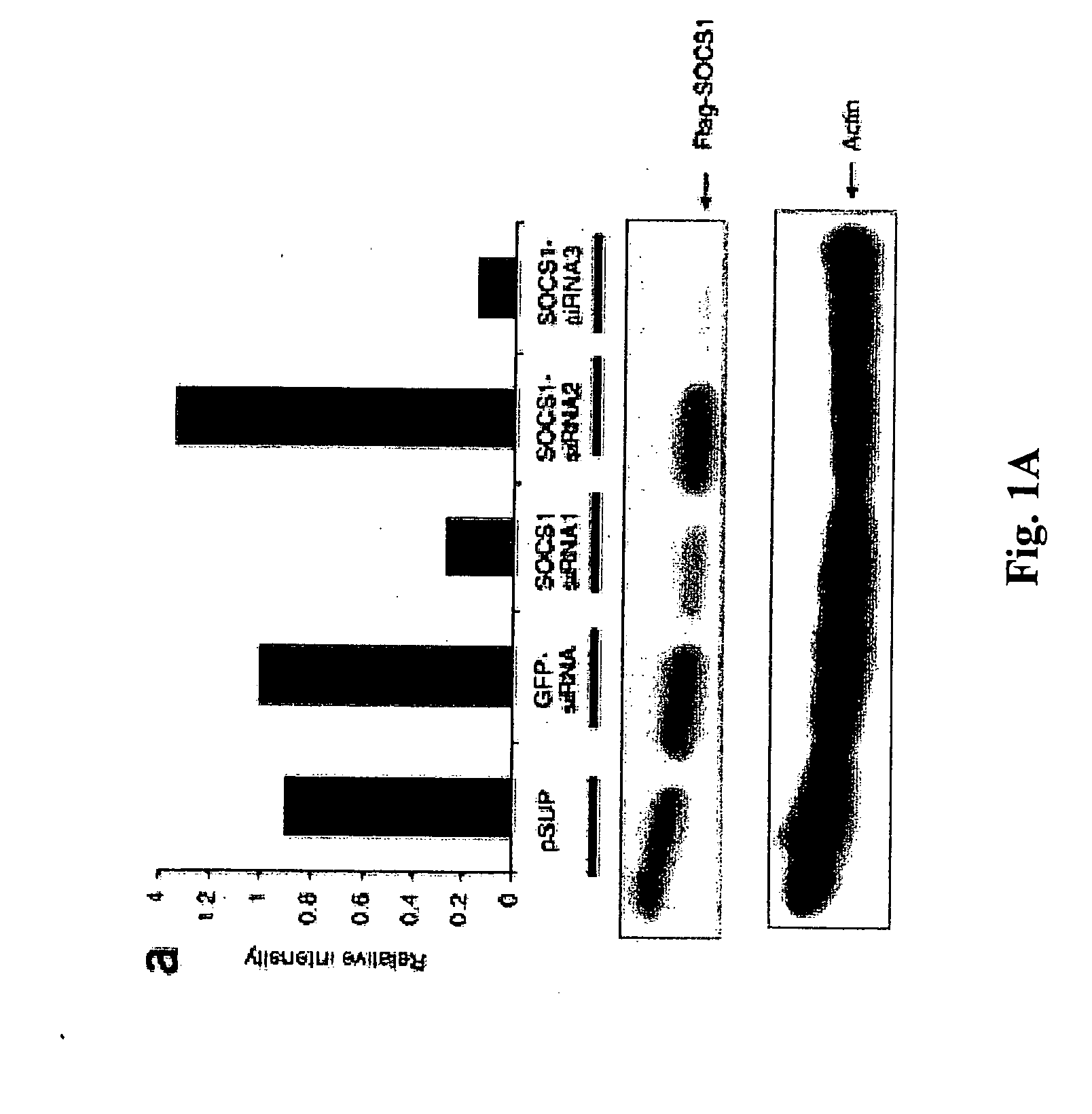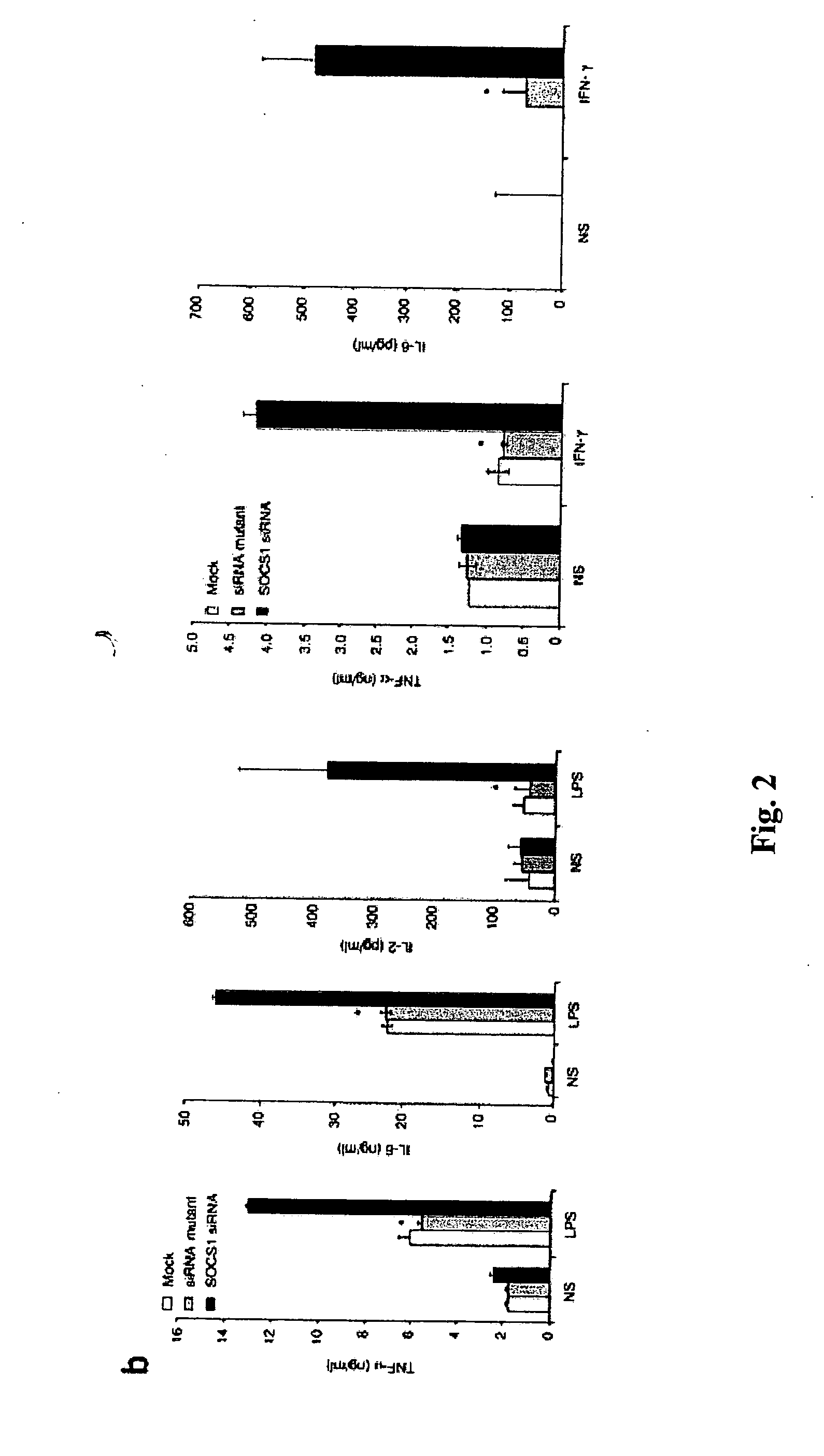Modulation of negative immune regulators and applications for immunotherapy
a technology of immune regulator and immunotherapy, applied in the field of immunotherapy, can solve the problems of insufficient induction of effective immune responses, limited induction of immune responses to self-tumor-associated antigens (taas), and failure of the human immune system to control and clear many pathogenic infections and malignant cell growth, etc., to achieve the effect of facilitating the integration of isolated polynucleotides
- Summary
- Abstract
- Description
- Claims
- Application Information
AI Technical Summary
Benefits of technology
Problems solved by technology
Method used
Image
Examples
example 1
Identification and Analysis of Murine SOC-1 siRNA
[0375] A computer program was used to select siRNA sequences targeting mouse SOCS1: SOCS1-siRNA1 (CCTTCCGCTCCCACTCCGA; SEQ ID NO:1), SOCS1-siRNA2 (CAGTCGCCAACGGAACTGC; SEQ ID NO:2) and SOCS1-siRNA3 (CTACCTGAGTTCCTTCCCCTT; SEQ ID NO:3). All target sequences were subjected to NCBI Blast query to confirm the lack of homology to other known genes. Forward and reverse oligos were designed to encode the sense and antisense 19nt target sequences separated by a 9nt spacer. This core siRNA sequence was flanked by the H1 RNA transcription initiation and 5T terminator sequences, and incorporated 5′ BglII and 3′HindIII compatible overhangs upon annealing. The DNA-based siRNA expression vector pSUPER (Brummelkamp, et al., 2002, Science 296:550-553) uses the H1-RNA promoter to direct de novo synthesis of siRNAs. Oligonucleotide pairs synthesized and annealed were cloned into a BglII / HindIII digested pSUPER vector. Positive clones were identified b...
example 2
Transfection and SOCS1 mRNA Downregulation of Murine BM-DCs with SOCS1 siRNA with GenePorter
[0379] To investigate SOCS1 regulation of antigen presentation by DCs, a small interfering RNA (siRNA) that specifically downregulates SOCS1 was first identified as described below.
[0380] Synthetic siRNA oligo duplexes were efficiently transfected into DCs derived from mouse bone marrow cells ex vivo in the presence of granulocyte-macrophage colony-stimulating factor (GM-CSF) and IL-4 by GenePorter with a transfection efficiency of 83%. Briefly, bone-marrow DCs were transfected with 21 base-pair siRNA oligonucleotides (5′-CTACCTGAGTTCCTTCCCCTT-3′; SEQ ID NO:3) using GenePorter, following the manufacturer's protocol. 3 μl of 20 μM oligonucleotides was added to 3 μl of GenePorter reagent and 94 μl of serum-free RPMI1640 and incubated at 25° C. for 30 minutes, after which 100 μl of the GenePorter / oligonucleotide mixture was added to each well of bone marrow-DCs and incubated for 4 hours at 37°...
example 3
Transfection of Murine BM-DCs with Viral Vectors
[0385] To assess whether SOCS1 negatively regulates DC antigen presentation in vivo, SOCS1 siRNA or a control green fluorescent protein (GFP) siRNA was cloned into a lentiviral vector (LV), which is capable of stably transducing DCs (Rubinson et al., 2003, Nat. Genet. 33:401-406; Schroers et al., 2004, Methods Mol. Biol. 246:451-459), so that the effect of SOCS1 silencing could be assessed more reliably. Two constructs were generated, LV-SOCS1-siRNA and LV-GFP-siRNA, both containing the yellow fluorescent protein (YFP) marker (FIG. 3) according to the methods described elsewhere herein. Transduction of bone marrow-derived DCs (>80% CD11c+) with either the LV-SOCS1-siRNA or the LV-GFP-siRNA vector routinely yielded 58-63% of culture cells positive for YFP. Consistent with the previous observation on siRNA oligo-transfected DCs, a lower level of SOCS1 mRNA in the total transduced DC population and enhanced secretion of proinflammatory c...
PUM
| Property | Measurement | Unit |
|---|---|---|
| Immunogenicity | aaaaa | aaaaa |
| Stability | aaaaa | aaaaa |
| Cytotoxicity | aaaaa | aaaaa |
Abstract
Description
Claims
Application Information
 Login to View More
Login to View More - R&D
- Intellectual Property
- Life Sciences
- Materials
- Tech Scout
- Unparalleled Data Quality
- Higher Quality Content
- 60% Fewer Hallucinations
Browse by: Latest US Patents, China's latest patents, Technical Efficacy Thesaurus, Application Domain, Technology Topic, Popular Technical Reports.
© 2025 PatSnap. All rights reserved.Legal|Privacy policy|Modern Slavery Act Transparency Statement|Sitemap|About US| Contact US: help@patsnap.com



